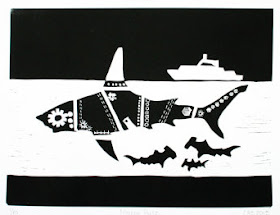I think I saw that it’s Shark Week again, so here are some relief block prints of these fascinating fish. We’ll begin with the most scientific one, which is nevertheless not the most realistic. In 1613, when Ulyssis Aldrovandi published his natural history works about fish, it can’t have been too easy to study sharks. He was doing pretty well just to realize that there were a number of different species and to note some of their peculiarities. This one, which Aldrovandi calls a fox shark, as far as I can make out (all sharks were commonly called dogfish in English at the time), certainly looks sharky enough about the head and gills. Its fins are rather feathery, more like other fish than the flippery fins of sharks, and there’s definitely something odd about the tail. Perhaps this is some sort of thresher shark? I like the pattern on the tail, even though I’m not sure exactly what it’s meant to depict, and I like the fierce teeth.
Perhaps the most realistic is this view of hammerhead sharks by Katherine Grey. The beautiful background is watercolor over mulberry paper, which has wonderful fibers all through it. The only time I was ever swimming with sharks, the water was actually only about chest deep, and the black-tipped reef sharks were relatively small. (Not that they couldn’t take a nasty chunk out of you if they were so inclined, but they weren’t.) The idea of having a school of sharks between me and the surface of the water, as in this piece, is considerably more unnerving. Beautiful, but terrifying.
Discovery Channel, the inventors of Shark Week, have been criticized (quite rightly) over the amount of shark fantasy that they’ve mixed with their shark science over the years, but I think it’s not inappropriate to include a bit of fantasy in this blog. After all, I’m a fantasy blogger, not a science programmer! So I’ve included this bold steampunk shark. I like to think that the hammerheads have built this shark as a decoy or trap for the fishing boat above. The artist of this piece donates her proceeds to conserve sharks and to work against the practice of killing sharks for their fin alone, an insanely wasteful trade.
Finally, another piece with a touch of the fantastic, by Roger Peet. He says it’s printed from three blocks, and I confess to being a little puzzled by that. There’s a distinct outline along the edge of the darker blue; as it isn’t a separate block of its own, it must be the effect of a slight overlap between the green block and the dark blue block. It’s very cool that the ink colors blend in that way. Again, although it’s beautiful, it’s a bit unnerving, because it represents the effects of rising sea levels.
I can’t say that I like sharks, or even that they’re one of the animals that particularly catches my imagination. But in some ways that’s all the more reason to celebrate them. After all, the creatures of this world, unlike the creatures of fantasy, exist for their own sakes, not merely for our interest.
[Pictures: Vulpecula alia, wood block print from De piscibus by Ulyssis Aldrovandi, 1613 (Image from AMS Historica);
Shiver of Hammerheads, linocut by Katherine Grey (Image from her Etsy shop TheGreyFoxStudio);
Moving Parts, linocut by Claire S. (Image from her Etsy shop TheGoodInk);
Drowned Apse, linocut by Roger Peet, 2015 (Image from his Etsy shop TooSphexy).]





No comments:
Post a Comment
I love to hear from you, but please no spam, ads, hateful language, or other abuse of this community.